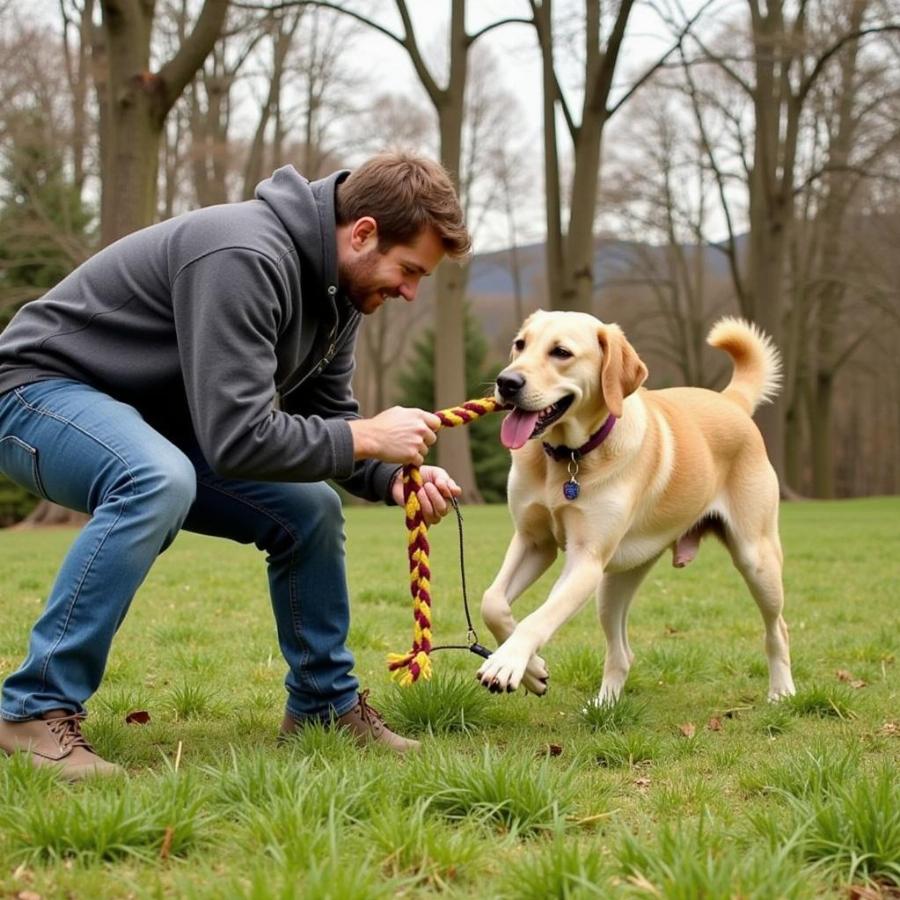When you hear “knotted by huge dog,” your mind likely jumps to the image of a tangled leash or perhaps even a more concerning scenario involving a dog fight. While both are possibilities, the phrase most often relates to rope toys knotted tightly through vigorous play, particularly with larger, powerful breeds. This article delves into the potential hazards of knotted rope toys for large dogs, focusing on injury prevention and responsible play. We’ll explore how these knots can pose a risk, discuss safer alternatives, and provide guidelines for ensuring your furry friend enjoys tug-of-war without harm.
The Dangers of Knotted Rope Toys for Large Dogs
Rope toys are a popular choice for dog owners, especially those with powerful chewers. However, the very durability that makes them appealing can also become a hazard when knots form. Large dogs, with their strong jaws and determined tugging, can tighten these knots to the point where they become incredibly dense and rigid. This can lead to a number of issues, including:
- Dental Damage: Sharp knots can chip teeth or abrade gums, causing pain and potential infection.
- Jaw Injuries: Trying to pry open a tightly knotted toy can strain jaw muscles and even lead to dislocations.
- Gastrointestinal Blockage: If pieces of the knotted rope are ingested, they can cause blockages in the digestive system, requiring surgery.
Choosing the Right Tug Toys for Your Big Buddy
Selecting appropriate tug toys for a large dog involves considering the material, durability, and size. Opt for toys specifically designed for tug-of-war, made from robust, non-toxic materials. Avoid ropes that fray easily, as loose strands can be ingested. Look for toys with handles that provide a comfortable grip for both you and your dog.
Safe Tug-of-War Practices
Playing tug-of-war can be a fun and engaging activity for you and your dog, but it’s crucial to establish rules and supervise play closely. Here are some guidelines to ensure safe tug-of-war sessions:
- “Drop It” Command: Teach your dog a reliable “drop it” command. This allows you to control the game and prevent excessive pulling or potential injury.
- Supervised Play: Always supervise tug-of-war sessions, especially with puppies or dogs prone to resource guarding.
- Regular Inspections: Regularly inspect toys for damage and discard any that are frayed, torn, or knotted excessively.
- Appropriate Size: Choose toys that are appropriately sized for your dog’s mouth. Avoid toys that are too small, as they could be swallowed.
 Chơi kéo co an toàn với chó lớn
Chơi kéo co an toàn với chó lớn
Alternatives to Rope Toys
If you’re concerned about the risks associated with knotted rope toys, several safer alternatives exist:
- Durable Rubber Toys: Many durable rubber toys are designed for chewing and tugging.
- Fleece Toys: Fleece toys are soft and gentle on teeth and gums, making them a good choice for sensitive dogs.
- Firehose Toys: Made from recycled firehose material, these toys are exceptionally durable and resistant to tearing.
What if My Dog Swallows a Knotted Piece of Rope?
If your dog swallows a knotted piece of rope, contact your veterinarian immediately. Gastrointestinal blockages can be life-threatening and require prompt medical attention.
Conclusion
While rope toys can be enjoyable for dogs, knotted ropes, especially with larger breeds, present potential hazards. By understanding the risks, choosing appropriate toys, and practicing safe play, you can help your furry friend enjoy tug-of-war without injury. Remember, responsible play and regular toy inspection are crucial for ensuring your dog’s safety and well-being.
FAQ
- Are all rope toys bad for dogs? No, not all rope toys are bad, but it’s important to choose durable, high-quality ropes and supervise play to prevent excessive knotting.
- What are the signs of a gastrointestinal blockage? Signs of a blockage include vomiting, diarrhea, loss of appetite, and lethargy.
- Can I untangle a knotted rope toy? If the knot is loose, you can try to untangle it. However, if it’s very tight, it’s best to discard the toy.
- What’s a good alternative to a rope toy for a powerful chewer? Durable rubber toys, firehose toys, and antlers are good alternatives for powerful chewers.
- How often should I inspect my dog’s toys? Inspect your dog’s toys regularly, at least once a week, and discard any that are damaged.
- What should I do if my dog gets injured during tug-of-war? Contact your veterinarian if your dog experiences any injury during tug-of-war.
- Is tug-of-war a good way to bond with my dog? Yes, tug-of-war can be a fun and engaging way to bond with your dog when played safely and responsibly.
Dr. Emily Carter, DVM, advises, “Always supervise your dog with any toy, especially those that can be chewed into smaller pieces or knotted tightly.”
Dr. Michael Davis, Certified Professional Dog Trainer, adds, “Teaching a solid ‘drop it’ command is crucial for safe tug-of-war play. It allows you to control the game and prevent potential injuries.”
Beaut Dogs is your trusted source for comprehensive information on all aspects of dog ownership. From breed selection to care guides, we’re dedicated to providing valuable resources for dog lovers. For personalized advice and support, contact us at Email: [email protected]. Visit Beaut Dogs for more helpful content!